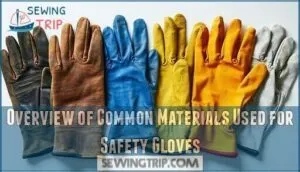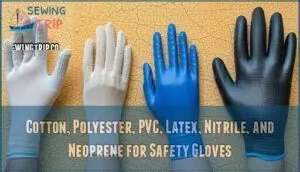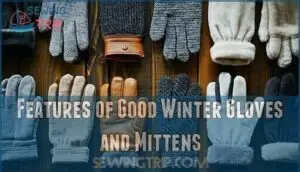This site is supported by our readers. We may earn a commission, at no cost to you, if you purchase through links.

You’ll find leather, loved for its durability and grip—perfect for heavy-duty tasks or winter warmth.
Cotton’s lightweight and breathable, making it ideal for gardening or light protection.
Polyester offers flexibility and cost-effectiveness, often used in sports gloves.
Need protection from chemicals? Synthetic options like nitrile, neoprene, and PVC are your go-to, offering both durability and resistance.
For colder climates, materials like wool or insulated synthetics keep your hands toasty.
With options suited to every task, there’s a glove fabric for every need—who knew hands could be so picky?
Table Of Contents
- Key Takeaways
- Overview of Common Materials Used for Safety Gloves
- Properties of Leather and Synthetic Leather for Safety Gloves
- Cotton, Polyester, PVC, Latex, Nitrile, and Neoprene for Safety Gloves
- Common Palm Coatings for Safety Gloves
- Materials for Winter Gloves and Mittens
- Features of Good Winter Gloves and Mittens
- Types of Hybrid Gloves and Mittens and Layering for Cold Weather Protection
- Frequently Asked Questions (FAQs)
- Conclusion
Key Takeaways
- You’ve got options: leather is durable for heavy-duty tasks, cotton is breathable for light work, and nitrile resists chemicals while being latex-free.
- Winter gloves shine with materials like wool for warmth and synthetics for flexibility, combining insulation and comfort.
- Palm coatings like nitrile or latex improve grip and durability for specific tasks, especially in wet or hazardous conditions.
- Layering gloves boosts protection in extreme cold—liners wick moisture, insulation traps heat, and outer layers block wind and water.
Overview of Common Materials Used for Safety Gloves
When you’re selecting safety gloves, understanding the fabric landscape can make the difference between protection and vulnerability.
The most common glove materials each bring unique strengths to your workplace arsenal.
Leather delivers exceptional material durability and natural water resistance, making it perfect for construction and welding tasks.
Cotton and polyester offer comfortable, breathable options for general work applications.
For chemical resistance, PVC and latex lead the pack, providing reliable barriers against harsh substances while maintaining grip enhancement.
Nitrile stands out as the allergenicity champion – it’s completely latex-free, eliminating allergic reactions while offering excellent tear resistance.
Neoprene brings flexibility to industrial settings where oils and acids are present.
These base materials often feature specialized palm coatings like polyurethane or nitrile rubber, which boost grip and durability.
The thermal properties vary substantially between materials, so consider your working environment’s temperature demands.
Understanding glove fabric composition helps you match the right material to your specific job requirements, ensuring both safety and comfort throughout your workday.
To achieve perfect fit and comfort, consider the key measurements for creating customized gloves.
Properties of Leather and Synthetic Leather for Safety Gloves
Looking for dependable hand protection? Leather gloves and synthetic leather options both excel, but they shine in different ways.
Leather durability makes it a trusted choice for tough jobs, while synthetic strength offers modern perks like water repellence and eco-friendliness. Leather flex ensures comfort, even during extended use, while synthetic fibers provide consistent performance in varied environments.
- Leather Types: Natural leather like deerskin offers unmatched flexibility and resilience.
- Synthetic Strength: Materials mimic leather’s durability, adding extra water resistance.
- Safety Features: Both materials handle tough tasks effectively.
- Material Comparison: Leather excels in extreme heat; synthetics resist oils better.
When working with synthetic leather, understanding sewing vinyl leather techniques is vital for achieving professional results.
Cotton, Polyester, PVC, Latex, Nitrile, and Neoprene for Safety Gloves
Glove materials matter in terms of safety and comfort.
Cotton gloves are breathable, great for light tasks, and reusable, while polyester gloves add durability and strength.
PVC gloves shine for chemical resistance and grip, ideal for handling oils and solvents.
Nitrile gloves offer excellent hand protection, blending tear resistance and a latex-free option for allergens.
Latex gloves are flexible and precise but may trigger allergies.
Neoprene gloves bring flexibility and toughness for oily or acidic environments, ensuring robust chemical resistance and providing a latex-free option.
Common Palm Coatings for Safety Gloves
The right palm coating can make your safety gloves a game-changer.
Whether it’s a nitrile coating for oil protection, a latex finish for superior grip, or a PVC layer for wet conditions, it’s all about matching the material to the job.
Here are three top options:
- Foam Grip: Adds flexibility and a secure hold, even in slippery situations.
- Polyurethane Coat: Lightweight, great for delicate tasks needing precision.
- Nitrile Coating: Durable and chemical-resistant, ideal for handling hazardous materials.
Materials for Winter Gloves and Mittens
When it’s freezing outside, you need gloves that keep your hands warm without sacrificing flexibility.
Materials like wool, leather, and advanced synthetics provide insulation, durability, and protection against the elements.
Wool and Synthetics
Wool insulation is like wrapping your hands in a cozy blanket, offering natural thermal regulation even if it gets damp.
Synthetic blends, on the other hand, excel in flexibility and durability, making them perfect for active, cold-weather tasks.
These winter materials combine warmth and protection, with synthetic glove fabrics often incorporating breathable layers for comfort.
While wool retains warmth exceptionally well, durable glove fabrics like polyester and nylon are ideal for tough conditions.
Choosing flexible glove fabrics guarantees comfort without sacrificing performance.
The quality of wool glove materials can substantially impact the overall warmth and durability of the gloves.
Leather
Leather is a standout in winter glove materials, combining durability, protection, and timeless appeal.
Made from animal hides like cowhide, pigskin, or goatskin, leather gloves provide excellent insulation and water resistance, especially when paired with grain or split finishes.
Reinforced fingers and palms boost grip and flexibility, perfect for reducing hand fatigue during daily tasks.
Care matters too—proper cleaning and conditioning maintain leather’s durability and thermal properties.
Thanks to the tanning process, leather can weather harsh conditions while keeping your hands warm and dry.
Whether stylish or rugged, leather gloves are an investment worth making for comfort and performance in cold weather.
For peak performance, consider high-quality leather glove options to guarantee the best fit and functionality.
Features of Good Winter Gloves and Mittens
When choosing winter gloves or mittens, you’ll want something functional, comfortable, and built for cold conditions.
Look for features like proper insulation, water and wind resistance, and breathable materials to keep your hands warm and dry.
Functionality and Comfort
When choosing gloves, think about comfort and ease of movement. It’s like finding the perfect pair of shoes—you want the right fit and features for the job.
Grip enhancement, solid finger dexterity, and hand mobility make tasks easier while keeping you warm.
Look for features like:
- Reinforced palms for traction on slippery surfaces.
- Adjustable wrist support to keep gloves snug and stable.
- Breathable glove fabric to keep hands dry and comfortable.
- Sensory feedback from flexible materials for precise movements.
Refer to a glove material guide to pick the best fabrics for performance and comfort.
Thermal Insulation, Water and Wind Resistance, and Breathability
Keeping your hands warm in winter isn’t just about bulk—it’s the fabric that counts. Gloves with thermal insulation, water resistance, and breathable materials can keep you comfortable without compromising movement.
Look for waterproof glove fabrics like Gore-Tex or neoprene to block out moisture from snow or rain. For wind resistance, fabrics like polyester shells or leather treated with repellents work wonders.
Moisture management is key, too—nobody likes sweaty palms on a cold day! Moisture-wicking linings keep sweat under control, while breathable glove fabrics prevent overheating. Combine insulation with breathability for the best experience.
| Feature | Material Examples | Benefits | Usage Environment | Notes |
|---|---|---|---|---|
| Thermal Insulation | Wool, Thinsulate | Retains heat | Cold weather | Effective even in snow |
| Water Resistance | Neoprene, Gore-Tex | Blocks moisture | Wet or rainy conditions | Maintains dryness |
| Wind Proofing | Polyester, Leather | Stops wind gusts | Outdoor activities | Better flexibility |
| Breathable Materials | Perforated leather | Prevents sweat | High-intensity use | Ideal for prolonged wear |
| Moisture Management | Moisture-wicking linings | Controls sweat | Active environments | Keeps hands comfortable |
Types of Hybrid Gloves and Mittens and Layering for Cold Weather Protection
When it’s freezing outside, layering systems for hand protection can make all the difference. Hybrid gloves and cold mittens are perfect examples of combining materials for warmth and usability. Imagine this scenario: you’re on a snowy mountain, gripping ski poles, and icy winds hit your hands. What’s your best ally? Layers.
Start with thin liner gloves, which provide a base of warmth and protect against small abrasions. Over those, wear thick wool or synthetic-blend mitten shells for thermal insulation. Finish with waterproof, windproof overmitts to keep moisture and biting winds at bay.
Here’s why layering works:
- Better insulation: Each layer traps heat, helping fight off the chill.
- Adaptability: Remove or add layers based on activity or temperature.
- Moisture management: Breathable glove fabrics, like polyester, prevent sweat buildup.
The key to effective layering lies in understanding hybrid mitten technology. Snug-fitting layers won’t sacrifice dexterity. You’ll stay warm and ready for winter adventures!
Frequently Asked Questions (FAQs)
What materials are used to make gloves?
Gloves are made from materials like leather, cotton, polyester, nitrile, vinyl, and neoprene.
Each serves a purpose—whether it’s keeping hands warm, protected from chemicals, or ready for detailed tasks with grip and flexibility.
What are the different types of gloves?
Gloves come in types like nitrile, latex, vinyl, leather, and hybrid styles.
Each serves different needs—protecting hands from chemicals, offering thermal insulation, or ensuring grip in wet or dangerous conditions.
Choose what fits best!
Is there a universal glove material?
There’s no one-size-fits-all material for gloves, just like there’s no perfect pizza topping.
Each fabric—leather, nitrile, cotton—offers unique strengths suited to tasks, from durability to chemical resistance.
Your choice depends entirely on your needs, and each fabric has its own strengths.
What materials are used in football gloves?
Football gloves use materials like silicone for superior grip, neoprene for flexibility, and polyester blends for durability and moisture-wicking.
Some include breathable mesh to keep your hands cool, ensuring solid performance on the field, with features like moisture-wicking.
What are disposable gloves made of?
Disposable gloves are usually made from nitrile, latex, or vinyl.
Nitrile offers strength and chemical resistance, latex provides flexibility but can trigger allergies, while vinyl is an affordable choice for lower-risk tasks.
Choose wisely!
What is the best material for safety gloves?
When choosing safety gloves, focus on the hazards you’ll face.
Nitrile offers chemical resistance, Kevlar resists cuts, and leather adds durability.
The best material depends on your task, environment, and the protection you need.
What are the most popular brands of gloves and mittens?
In the realm of glove and mitten brands, names like The North Face, Hestra, Black Diamond, Carhartt, and Under Armour stand out.
They blend durability, warmth, and style, keeping you ready for any adventure.
Are hybrid gloves and mittens suitable for very cold weather?
Hybrid gloves and mittens work well in very cold weather if they combine insulation, waterproofing, and layering materials like Thinsulate or fleece.
Proper fit and additional liners boost warmth, keeping your hands cozy and flexible, utilizing materials like fleece.
Is leather the best material for safety gloves?
Think of leather as the knight’s armor—it’s durable, water-resistant, and protects well in rough conditions.
However, the best safety gloves depend on the task, and materials like nitrile, Kevlar, or neoprene might suit specialized needs better.
Are there any benefits to wearing multiple layers of gloves and mittens?
Layering gloves and mittens boosts warmth, maintains flexibility, and protects against extreme cold or hazards.
Thin liners wick moisture, outer mittens block wind, and insulation regulates heat—kind of like dressing your hands in cozy armor!
Conclusion
Choosing the right gloves isn’t just about fit—it’s about function. Whether it’s durable leather, breathable cotton, or chemical-resistant nitrile, the question "what fabric are gloves made of" depends on your specific needs.
For winter warmth, wool or insulated synthetics shine, while hybrid designs offer versatile protection.
Understanding fabrics lets you match gloves to your tasks, ensuring comfort and safety. So next time you gear up, let the material guide your choice—your hands deserve the best.
- https://www.heatholders.com/blogs/wow/everything-you-need-to-know-about-mittens-vs-gloves-for-skiing-1?srsltid=AfmBOoqs-_P0Ys12izGdzb7isp3BcGuIflTziEtQy7-1SgofCtQchO-9
- https://www.stio.com/blogs/clothing/fleece-mens-winter-gloves
- https://www.thegreatoutdoorsmag.com/gear-guides/best-winter-gloves-for-hiking-and-walking/
- https://gearjunkie.com/winter/world-s-best-winter-mitts
- https://www.outdoorlife.com/gear/best-winter-gloves/













